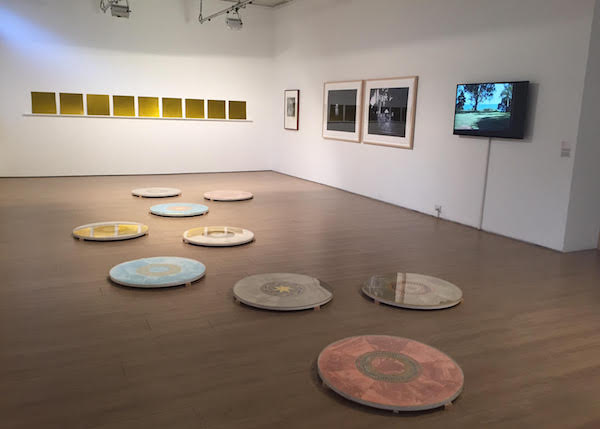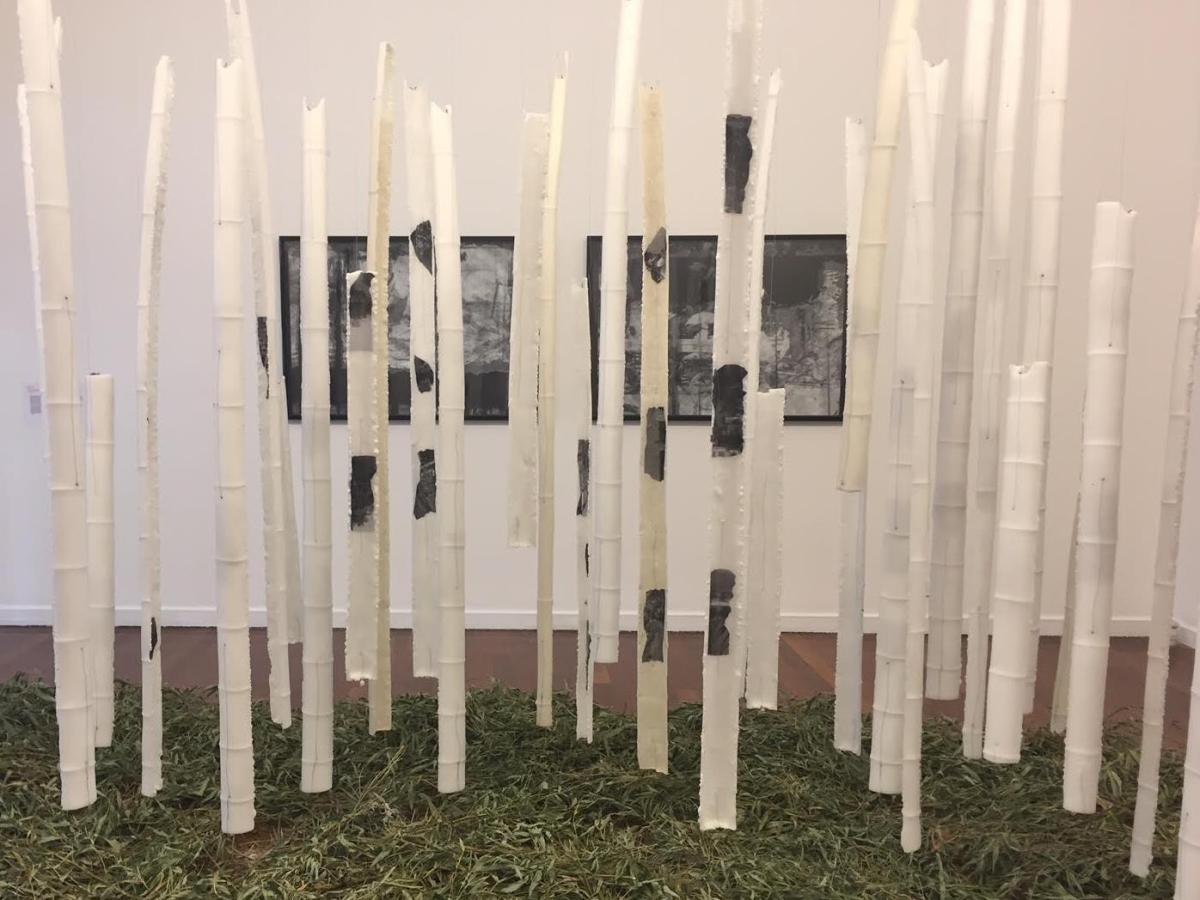Installation view Et in Arcadia Ego (2017) at 4A Contemporary Art Centre; courtesy the artist; Photo ArtsHub
Curating a survey exhibition of an artist’s career and omitting the artist’s most iconic, signature work is in interesting move. But that is what 4A Centre for Contemporary Asian Art curator Pedro de Almeida has done for this survey exhibition of Dacchi Dang, titled An Omen Near and Far.
While for many that might be “survey suicide”, curatorially it is one of the smartest and bravest moves I have seen for a while.
De Almeida made the call to omit The Boat, on the basis that Dang’s installation of an iconic refugee vessel would dominate the dialogue and tone of the show.
He also made the call given the large and seminal work had been presented in the space in 2001, when it opened up strong public dialogue around the ‘perils of seeking asylum’. While that conversation remains important across Dang’s career, it does not exclusively underpin his choices as an artist.
What viewers are left with is an exhibition that’s subtle and nuanced, and which fleshes out the breadth of Dang’s oeuvre, moving from locations in Paris, Queensland’s Peel Island, and Sydney.
Creating impact
Walking into the downstairs gallery visitors are faced with a new installation commissioned by 4A for Dang’s survey, titled Et in Arcadia Ego (2017). A “forest” of cast wax bamboo forms embedded with small hand-printed photographs hover in the space. Photographs also line the walls of the street level gallery. Dang has planned for the sculpture to slowly melt over the duration of the exhibition through a series of performances.

Detail of installation
The photographic imagery was recorded by the artist during a trip to Vietnam last year – the first visit to his country of birth since arriving in Australia in 1982 as a refugee.
The title references Nicolas Poussin’s painting in the Louvre by the same name, and serves as a similar momento mori in ‘its rendition of the destruction of a civilisation in an idyllic rural landscape’.
The symbolism of a melting bamboo forest is suggestive of the disastrous effect that chemical defoliants have wrought in Vietnam; a legacy of war.
The gallery explained: ‘This new work is conceptually connected to an earlier, ephemeral sculpture and performance originally staged as Upstairs/downstairs at Sydney’s National Art School in 1994.’
Documentation is a thread that runs across this exhibition – the constant push and flow of time, how we manage those memories and use them to construct who we are.
The upstairs galleries start to play out the range of Dang’s career, moving between videos, a floorpiece, printmaking, ephemera, and suites of photographs that are incredibly rich in their sense of moment.
The gallery explained: ‘Having shot over 100 rolls of black-and-white film on his Hasselblad, Dang’s photographic archive of daily life in urban and rural Vietnam documents a time concurrent with the momentous historic occasion of the lifting of the trade embargo between the U.S. and the Republic of Vietnam that had been in place since the end of military conflict in 1975.’
De Almeida has approached this amazing archive of Dang’s negatives and transparencies in a most pragmatic way – flicked through as a folder of contact sheets and an iPad “time capsule” that walks you through the past, as Australia was coming to terms with its Asian identity.
We forget that today a younger generation has no idea of what a contact sheet looked like; how images were selected.
As de Almedia writes: ‘An Omen Near and Far signals the central importance of art in coming to terms with the contingencies of the past and of the present.’
Another quirky treat on entering the upper gallery is a Certificate of Commendation, 1982 – a stamped official document from the Pulau Bidong Refugee Camp in Malaysia where Dang arrived as a refugee fleeing Vietnam – but unlike the usual photocopied form issued for encouragement, Dang designed his own. It acts as another anchor to reality despite its almost surreal inclusion in this broader story of making histories.

Certificate of Commendation, 1982, installation view, 4A Centre for Contemporary Asian Art. Courtesy the artist. Image: Document Photography.
There are some real gems in this exhibition, if you allow yourself the time to “sniff around” it – it doesn’t have the kind of pace or bravado that we have become nurtured to expect in our art appetite, and yet it has its own seductions.
Dang’s photography is stunning; and better still, this is thinking photography as it ‘explores landscape as colonised and contested forms of cultural memory’.
The series Shadow Chasing I-VI (2006) and Liminal (2005) were produced following a residency in Paris. For Liminal, de Almedia has lined up nine montages from the series juxtaposing urban scenes from Paris and Saigon. With his knowledge of the media and push to experiment, Dang turned to a mid-19th century photographic process that emerged at the same time as the French began to occupy regions of modern-day Vietnam – comprised of watercolour and gum bichromate.
Demonstrating the depth of Dang’s images and making, these images frame intricate geometric patterns that reference Bronze Age Vietnamese Đông Sơn drums, what de Almeida explains as a comment on the many ‘such revered artefacts were stolen from Vietnam for French national collections. Liminal evokes the spectre of distance—geographic and historic—that such cultural displacement ruptures.’

Installation view Dacchi Dang – An Omen Near and Far at 4A gallery; Photo Artshub
Dang is an important artist in the trajectory of contemporary Asian art in Australia, and for this reason alone it is worth seeing this exhibition.
De Almeida concludes: ‘An Omen Near and Far is a testament to the central importance of art in coming to terms with the contingencies of the past so that we might better understand the meaning of our present and shared futures.’
A founding member of 4A Centre for Contemporary Asian Art, Dang was born to a Chinese father and Vietnamese mother, and at the age of 16 fled Vietnam with his brother and sister on a fishing boat. He was accepted as a Vietnamese refugee by Australia in late 1982.
Rating 3 ½ stars out of 5
Daachi Dang: An Omen Near and Far
4A: Centre for Contemporary Asian Art, Sydney
9 June – 30 July 2017





